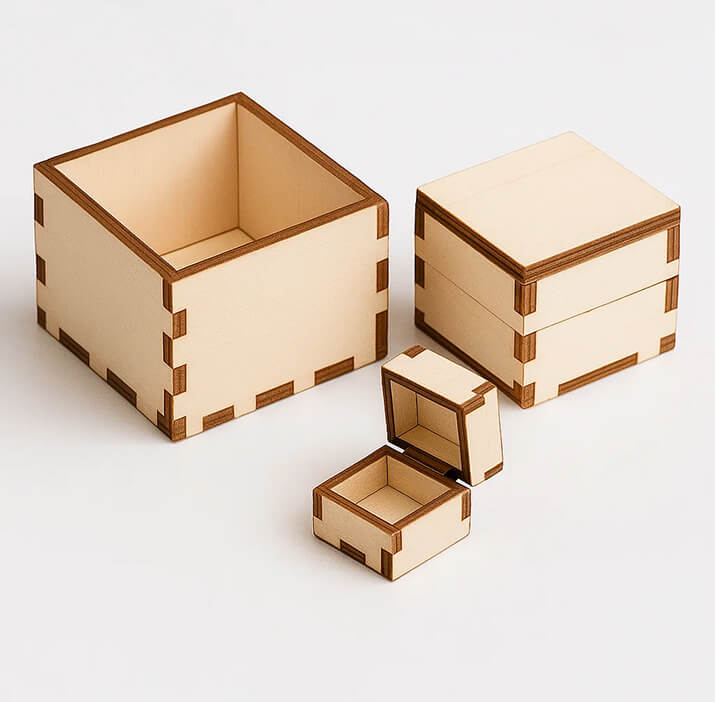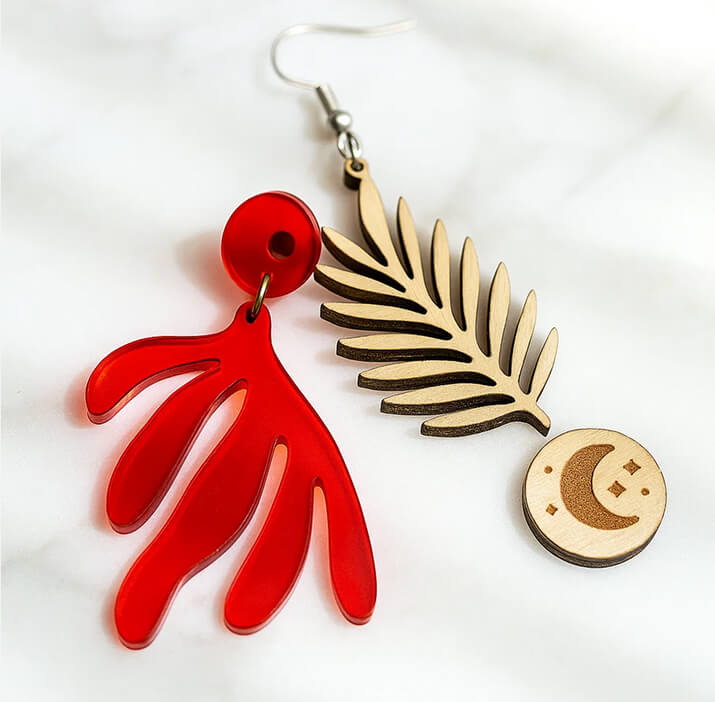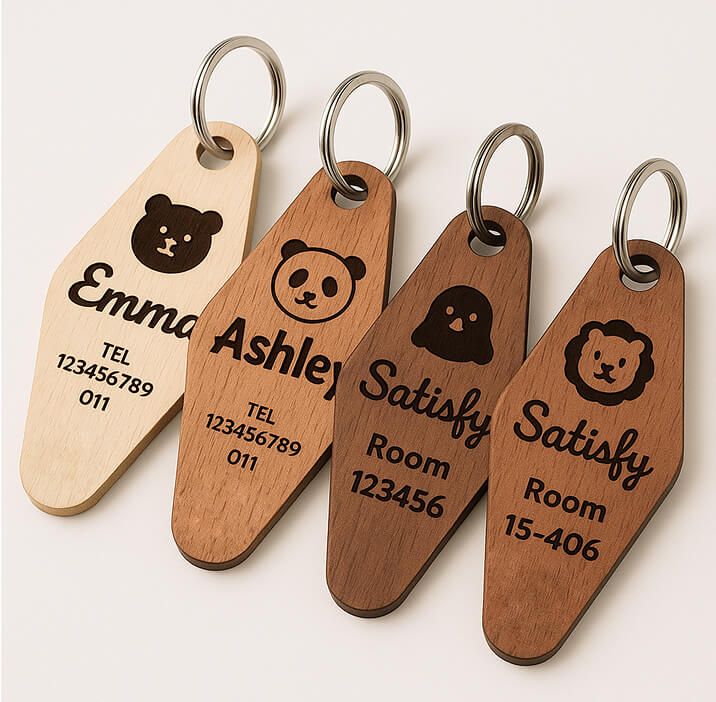Report
![[Laser cut and engrave] Rocker Light Switch Covers](https://image-res.xtool.com/resource/xtool/community/attachment/xtool-community/7c646e66-d4c6-4fdb-8b75-665eadaa4e60?x-oss-process=image/resize,w_1200,h_900,limit_0/interlace,1/format,webp/auto-orient,1)
Rocker Light Switch Covers
2LightSwitchCovers
.xcs
Application scenario
Laser (8min)
Machine & module
xTool D1 Pro
20WMaterial used
3mm Basswood Plywood A4
56
832
Information
I HATE light switch covers! They're plastic, plain, boring, never match your decorating and, if you have rocker switches, then there are never ones that are ornate or themed. However, with an Xtool there is no need to ever buy another one. Just make your own and decorate how you please. In this tutorial I will show you how.
Instruction
1
Step1: Make Switch Cover Faceplate
Preview
Preview
Preview
5 More images
- Open a new project in XCS (XTool Creative Space) by selecting File (the folder icon) → New from the Top Navigation menu.
- Create a rectangle by clicking Insert→ rectangle from the left menu and drag it onto the left top of your workspace
- Set the dimensions of the rectangle to 2.75"w x4.5"h.
- With the rectangle selected, set the Corner radius(in) to 0.1 using the input box located on the far right of the top menu.
- Create another rectangle the same way you did in #2 above.
- Set the dimensions to 1.286"w x 2.6"h. DO NOT ROUND THE CORNERS.
- Place the smaller rectangle inside the larger rectangle and select both by clicking on one and then the other while holding down the shift key.
- Center the smaller rectangle inside larger rectangle using Align → Horizontal align center and Align → Vertical align center from the top menu.
- With both rectangles still selected, group the 2 rectangles by clicking the Group icon from the top menu.
- Create a circle by clicking Insert → circle from the left menu and drag it onto the workspace
- Set the dimensions of the circle to 0.25"w x0.25"h.
- Select the circle click Ctl-C and then Ctl-v (Cmd-c & Cmd-v on a Mac) to copy and paste a second second that is the same size.
- Move one of the circles to the top inside of the light switch cover object you have created thus far. Set the top of the circle to 1/8th" (0.125") from the top edge of the light switch object.
- Move the other circle to the bottom inside of the light switch object. Set the bottom of the circle to 1/8th" (0.125") from the bottom edge of the light switch object.
- Center both circles horizontally by selecting all 3 objects and click Align → Horizontal align center from the top menu.
- Select all shapes and group them together by dragging a box around all the objects and then clicking the Group icon from the top menu.
- In your Layer dialog box (located in the bottom left of your workspace) you should see only 1 layer with all of the objects located on that layer. If you see more than 1 layer, select those items on other layers and click the Move to link on the bottom right of the Layer dialog box and move them to colour assigned to Layer 1 by clicking on the correct colour radio button.
- Click on Layer 1 set the layer to Cut and 100/7/1 (Power/Speed/Pass) in the Object Settings dialog on the far right side or the XCS workspace.
- You have now created the top face of your rocker light switch cover!
2
Step2: Make Switch Cover Lip for the Back
Preview
Preview
Preview
- Select the rectangle you created above in Step 1 and click Ctl-C and then Ctl-v (Cmd-c & Cmd-v on a Mac) to copy and paste a second rectangle that is the same size with the same corner radius. You will probably have to ungroup these items do do so. Click on the light switch face plate you created in Step 1 above and click Ungroup from the top menu. Once you have copied a second rectangle remember to re-group your light switch cover face plate.
- Place the second rectangle right next to the first one on the design space. Make sure they do not overlap.
- Create a 3rd rectangle the same way you did in Step 1 above. Set the dimensions of the rectangle to 2.5"w x 4.25"h and set the Corner radius(in) to 0.1
- Place this newly created rectangle inside of the second rectangle and select both by clicking on one and then the other while holding down the shift key.
- Center the smaller rectangle inside rectangle #2 using Align → Horizontal align center and Align → Vertical align center from the top menu.
- Group the 2 rectangles and click Group from the top menu.
- Set the rectangle to Cut in the object settings on the right side using the following settings: 100/7/1 (Power/Speed/Pass).
- You have now created the lip which will go on the back of your light switch face plate and hold it away from the wall.
3
Step3: Decorate
Preview
Preview
Preview
3 More images
I have included 2 designs you may use to decorate your switch covers; one nautical themed and one nature scroll themed.
Nautical Switch Cover:
- For the nautical themed one I use a rope flourish and a ships wheel svg that I created. To add them to your switch, click Image and then locate RopeFlourish.svg image from where you saved it on your computer using the dialog box that pops up.
- Select the rope flourish you just added and click Ctl-C and then Ctl-v (Cmd-c & Cmd-v on a Mac) to copy and paste a second one that is the same size.
- With it still selected, Click Reflect → Reflect horizontally. You should now have 2 flourishes that are a mirror image of each other.
- Repeat Step 3 #2 and select the ShipsWheel.svg.
- repeat Step 3 #3 using the ships wheel to create a second ships wheel.
- With all 4 images (2 rope flourishes and 2 ships wheels) selected set them to Output, Processing type:engrave, Setting: 60/150/1 (Power/Speed/Pass) in the Object Setting dialog on the far right side of the workspace.
- With them still selected, go to the Layer dialog (bottom left corner of the workspace) and click the Move to link and choose a new colour from the popup. I generally use blue for cut, red for score and black for engrave but you can use whatever colours you'd like so long as you assign a specific unique colour for each processing type.
- Drag the images you just created in Step 3 on to your light switch faceplate (created in Step 1) and arrange them being careful that they completely inside the faceplate and do not fall inside your center smaller rectangle or the top or bottom circles (these are for the switch cover screws that attach your light switch plate to the wall).
Scroll Switch Cover:
- You should have a blank faceplate and lip object (created in steps 1 and 2 above) on your workspace. Click Shape → Border and choose the border in row 1, column 4
- Select the border shape, click the lock icon between the w and h boxes under Side (in) on the top menu and set the side to 2.68" w x 4.435"h
- With the border shape still selected, go to the Layer dialog (bottom left corner of the workspace) and click the Move to link and choose a new colour from the popup. I generally use blue for cut, red for score and black for engrave but you can use whatever colours you'd like so long as you assign a specific unique colour for each processing type.
- With the border shape still selected, selected set them to Output, Processing type:engrave, Setting: 60/150/1 (Power/Speed/Pass) in the Object Setting dialog on the far right side of the workspace.
- Drag the border shape onto your faceplate and center it by selecting yur faceplate shape and your border shape while holding down the shift key and clicking Align → Horizontal align center and Align → Vertical align center from the top menu.
- You now have a decorated faceplate for your light switch cover.
4
Step4: Cut, Engrave and Score
Preview
- Place a 6"w x 5"h sheet of 3mm basswood plywood in your XTool and align the crosshairs with the left top corner.
- Click Process.
- Click the framing button on the top right to make sure your wood is straight and covers the entire are of your light switch pieces.
- Click Start in the top right corner.
5
Step5: Assemble
Preview
Preview
- Once your light switch faceplate and lip is completed remove all the pieces from the XTool. Turn it over so that the decorated cover is facing down and the back side of the lip is facing up. Make sure the decorative side of the faceplate is facing down!
- Put a tiny dot of Gorilla Gel Superglue on the BACK SIDE of the lip about every inch, all the way around.
- Turn the lip over and place along the undecorated side of the faceplate matching up the top and side outside edges. Clamp in place. the glue dries fairly quickly but I usually leave them clamped for about 30 minutes.
- Feel free to colour your image and the surrounding scored embellishments. I use watercolour paint which I brush on but you can also use paint pens. Be creative and colour as much or as little as you'd like.
- I leave the salutation (engraved) plain as I like the engraved look of the wood but you can colour this as well or use a bit of epoxy with mica powder to give it colour as well.
6
Step6: Tips, tricks & Modifications
- Feel free to modify for any occasion, theme or decor.
- Use the shapes and borders in XCS to achieve the look you'd like
- Wingdings and other image based fonts are a great source for small shapes
- Feel free to coat the top with either a clear-coat spray or epoxy for a harder and glossier finish.
- Check the measurements against your actual rocker switch and adjust the size of your internal triangle on the faceplate and the size and placement of your screws. They should be standard but several of our switches are smart switches and the measurements are a smidge different.
- Make sure to put the back of your lip to the back of your faceplate when gluing.
Comments





